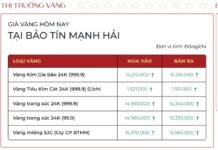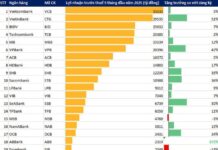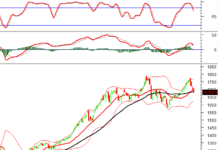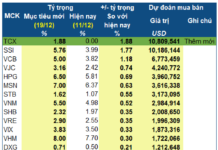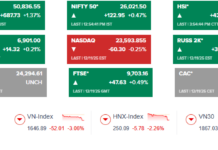
Illustrative photo.
Oil decreases due to negotiations in the Middle East
Oil price decreases more than 1 USD due to ceasefire negotiations between Israel and Hamas in Cairo, easing concerns about a broader conflict in the Middle East, while US inflation data blurs out the possibility of interest rate cuts coming soon.
At the end of the April 29th session, Brent crude oil futures for June, expiring on April 30th, decreased 1.1 USD or 1.2% to 88.40 USD/barrel. July futures contract decreased 1.01 USD or 87.20 USD/barrel. WTI crude oil decreased 1.22 USD or 1.5% to 82.63 USD/barrel.
Israeli airstrikes killed at least 25 Palestinian people and injured many others on April 29th, when Hamas leaders arrived in Cairo for a new round of negotiations with Egyptian and Qatari mediators. The Egyptian Foreign Minister said that Egypt is hopeful but is awaiting feedback on plans from both Israel and Hamas.
Markets are also watching the Federal Reserve’s monetary policy assessment on May 1st, which could provide guidance on the direction of interest rate decisions.
Investors are carefully considering the high likelihood that the Fed could raise interest rates by another quarter of a percent this year and next year as inflation and the labor market remain strong.
Moderate inflation in the US in March dampened expectations for near-term rate cuts. Easing inflation would increase the likelihood of rate cuts, which tend to stimulate economic growth and demand for oil.
In addition, the oil market is looking ahead to the closely watched US nonfarm payrolls report due on Friday.
Gold increases
Gold price increased due to a weaker US dollar, amid renewed focus on the US Federal Reserve’s policy meeting and US nonfarm payrolls data due this week for clues on the central bank’s interest rate trajectory.
Spot gold increased 0.2% to 2,342.41 USD/ounce. June gold futures closed up 0.4% at 2,357.7 USD/ounce.
The US dollar index fell 0.3% against its rivals, making gold more attractive for buyers using other currencies.
A higher-than-expected consumer price inflation report, released earlier this month, has tempered traders’ expectations for rate cuts by the Fed.
The Fed’s two-day policy meeting begins on April 30th. The US central bank is widely expected to hold its benchmark interest rate steady at the 5.25%-5.5% range at the end of its meeting on May 1st. Higher interest rates reduce the appeal of non-yielding gold.
Gold fell 2.2% last week, as tensions in the Middle East eased and expectations for imminent US rate cuts faded.
Copper at two-year high
Copper prices rose to their highest in two years in early trading on Monday on supply concerns, although signs of slowing demand in top consumer China kept the metal short of recent record highs
Three-month copper on the London Metal Exchange (LME) closed up 2% at $10,162 a tonne after touching a peak of $10,165 a tonne, close to a record high of $10,185 a tonne hit in March 2022.
Traders said sentiment was boosted by news that embattled Chinese property developer CIFI Holdings had agreed on a restructuring plan with its creditors. A downturn in China’s property and construction sector has weighed on the metals market.
Copper has been supported by expectations of supply shortages and rising demand from energy transition applications such as electric vehicles as well as new technologies like artificial intelligence and automation.
Weaker Chinese demand can be seen in Shanghai exchange copper stocks, which are near their highest in four years after rising above 287,000 tonnes from around 33,000 at the start of the year.
The International Copper Study Group sees a global copper market surplus of 162,000 tonnes this year.
Iron ore retreats on weak China industrial data
Iron ore futures fell after weak industrial data from China and as steelmakers completed restocking ahead of a holiday.
The most-traded September iron ore contract on China’s Dalian Commodity Exchange (DCE) ended down 0.51% at 874.50 yuan ($120.69) a tonne, having gained more than 14% this month.
On the Singapore Exchange, May iron ore futures were down 0.55% at $117.2 a tonne.
Official data showed that China’s industrial profits fell in March and growth in the first quarter slowed from the first two months of the year, raising doubts about the strength of the recovery in the world’s second-largest economy.
A note from analysts at investment bank CICC said daily hot metal output could rise above 2.3 million tonnes in the second quarter, but added that production will likely not be enough to eat into a significant build in iron ore port stocks in the first quarter.
In Shanghai, hot-rolled coil futures fell 0.18%, wire rod futures dropped 0.46%, and stainless steel futures lost 0.42%. Construction steel rebar, however, inched up 0.14%.
Coffee firms
July robusta coffee closed up $13, or 0.3%, at $4,164 a tonne. The contract had touched a record high of $4,338 a tonne last week.
Dealers said the market continued to draw support from concerns about dry weather in top robusta producer Vietnam.
Vietnam exported 756,000 tonnes of coffee in the first four months of this year, up 5.4% from the same period last year.
July arabica coffee rose 1.6% to $2.275 per lb.
Sugar rises
Raw sugar futures for May delivery closed up 4.1% at 20.20 US cents per lb.
Dealers said the May contract, which expires on April 30th, is providing the main focus in the short term.
White sugar futures for August rose 1.8% to $573.80 a tonne.
Corn, wheat ease; soybeans rise
Corn futures on the Chicago Board of Trade ended mostly lower as a drop in wheat and soybeans added to the day’s bearish market sentiment.
CBOT July corn ended down 3/4 cent to $4.49-1/4 a bushel.
Wheat settled down more than 2%, ending a seven-session rally as rain forecasts in southern Russia eased dryness concerns in the world’s top wheat exporter.
CBOT July wheat ended down 13-3/4 cents at $6.08-1/2 a bushel, pulling back from its highest






